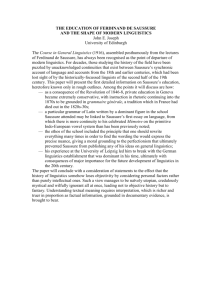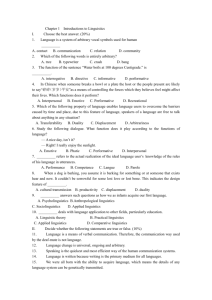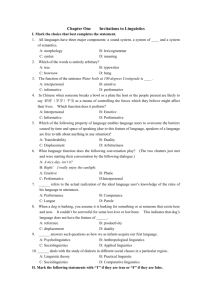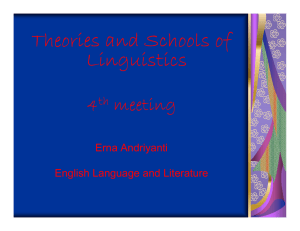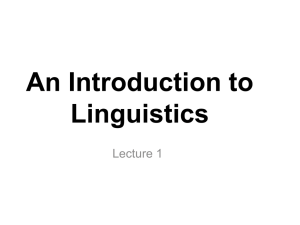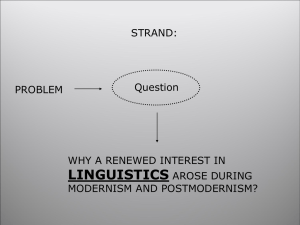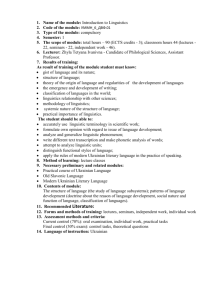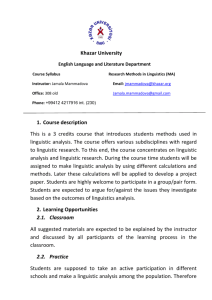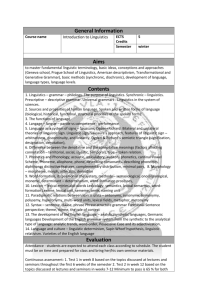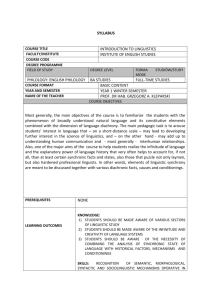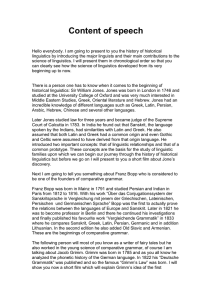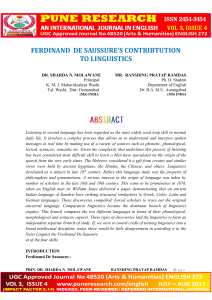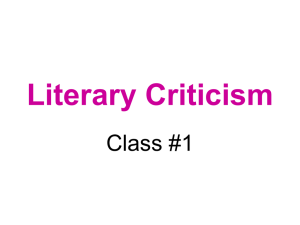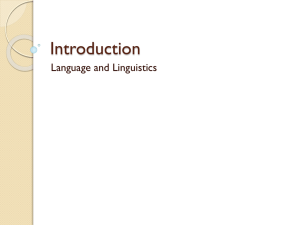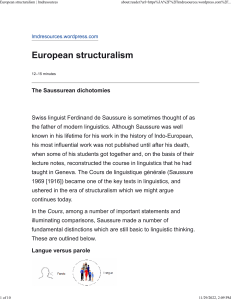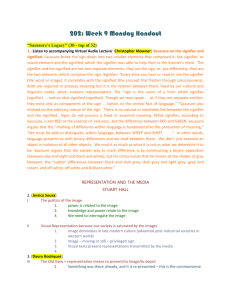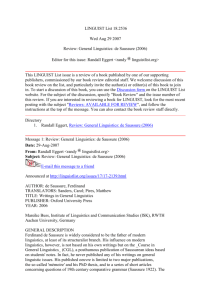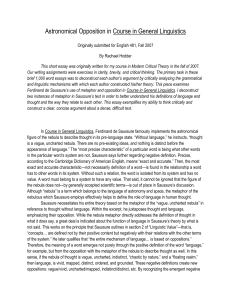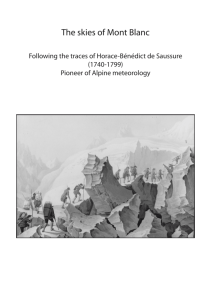pubdoc_12_14526_1734
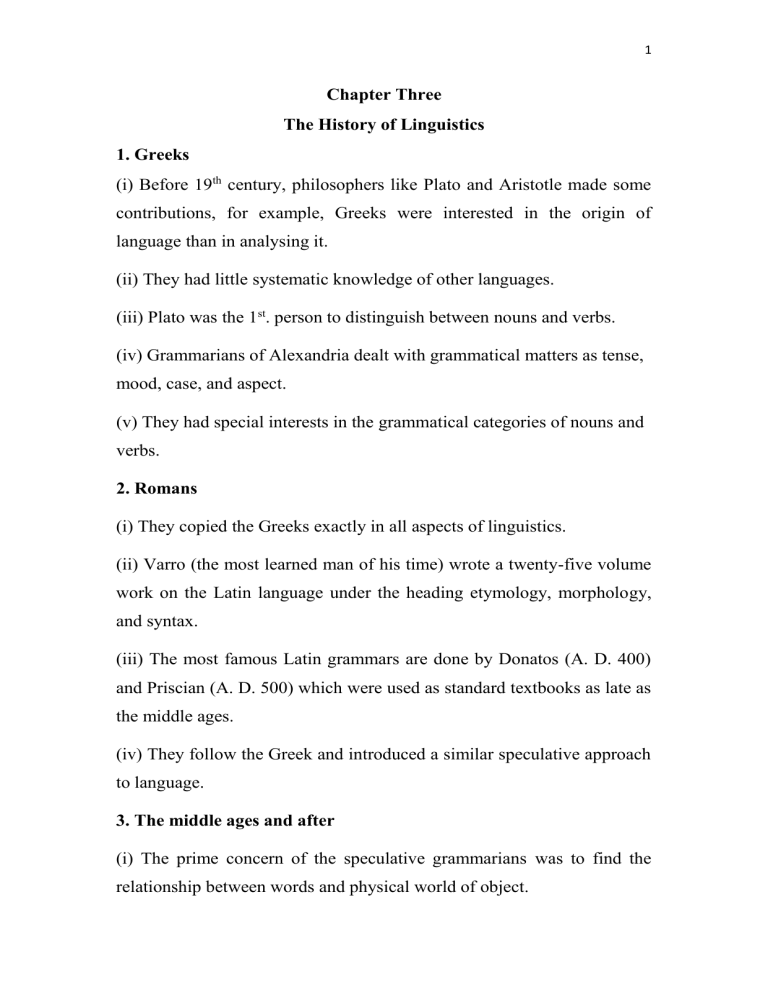
1
Chapter Three
The History of Linguistics
1. Greeks
(i) Before 19 th century, philosophers like Plato and Aristotle made some contributions, for example, Greeks were interested in the origin of language than in analysing it.
(ii) They had little systematic knowledge of other languages.
) iii
(
Plato was the 1 st . person to distinguish between no uns and verbs.
(iv) Grammarians of Alexandria dealt with grammatical matters as tense, mood, case, and aspect.
(v) They had special interests in the grammatical categories of nouns and verbs.
2. Romans
(i) They copied the Greeks exactly in all aspects of linguistics.
(ii) Varro (the most learned man of his time) wrote a twenty-five volume work on the Latin language under the heading etymology, morphology, and syntax.
(iii) The most famous Latin grammars are done by Donatos (A. D. 400) and Priscian (A. D. 500) which were used as standard textbooks as late as the middle ages.
(iv) They follow the Greek and introduced a similar speculative approach to language.
3. The middle ages and after
(i) The prime concern of the speculative grammarians was to find the relationship between words and physical world of object.
2
(ii) They believe that grammar is universal.
(iii) They were also interested in the origin of language, whether or not all languages came from a single source.
(iv) They believe that Hebrew was Man's original language.
4. Sir William Jones (1786) and the 19 th C. a) 1786
(i) He pointed out that Sanskrit (the old Indian language), Greek,
Germanic, Latin and Celtic all had structural similarities.
(ii) He concluded that all these languages sprang from one common source. b) 19 th Century
(i) Linguists in the 19 th Century concentrated on writing detailed comparative grammars, comparing the different Cal forms of the various members of the Indo – European language family.
(ii) They focused on written records.
(iii) The interest was historical analysis and interpretation. c) Junggrammatiker ( or Young grammarians/Neo grammarians ) i) They centred near Leipzing, investigated the sound change of many )
European languages.
(ii) They thought that sound laws are regular (without exceptions).
(iii) Older scholars objected this view and pointed out numerous exceptions to these so called laws.
3
5. The 20 th Century and de Saussure (1857 1913 ) [= Dichotomies]
De Saussure is the founder of modern structural linguistics. He was a lecturer in Geneva University. De Saussure's central ideas concerning the study of language were expressed in the form of pairs of concepts
(dichotomies). a) Diachronic Vs. Synchronic.
In diachronic study de Saussure sees language as continually changing medium. Whereas he sees it as a living whole existing as a state a particular moment of time in synchronic approach. b) Langage , langue , and parole
(i) Langage is the faculty of speech present in all normal human beings due to heredity – our ability to talk to each other.
(ii) Langue (language system) refers to the abstract knowledge of language. It represents the generalized system of rules and word images stored in the minds of individuals or native speakers.
(ii) Parole (language behaviour) refers to the actual physical utterance. It is the realization on of langue in speech. It refers to the actual and concrete act of speaking on the part of a person (a dynamic social activity) in a particular time and place. c) Signifiant Vs. signifie'
(i) Signifiant is one side to the study of meaning referring to the thing that signifies sound/ image.
(ii) Singnifie' is one side to the study of meaning denoting the thing signified / concept.
(iii) Following de Saussure , Linguistic sing is the relationship between signifiant and signifie', and is the basic unit of communication within a community.
4 d) Syntagmatic Vs. paradigmatic
(i) Syntagmatic indicates the horizontal relationship between linguistic elements forming linear sequences in the sentence, as in
- She can go
- Come quickly
(ii) Paradigmatic (or associative) refers to the vertical relation slip between linguistic signs that might occupy the same particular place in a given structure.
syntagmatic
→
- She + can + go paradigmatic ↓ - He + will + come
I + may + sit
Q : Why in America linguistics developed far faster than in Britain?
A : This was due to the presence of numerous American Indian languages which were fast becoming extinct and scholars rushed to record them before it was too late.
Q : What is language in the viewpoint of de Saussure?
A : According to de Saussure, language is a system of relations. His aim was that he wanted to define language as an object that can be studied scientifically. He pointed out the structural nature of language, the fact that its elements are essentially interlinked. He compared language to a game of chess; it is the relationship of each chessman to other chessmen which is the essence of the game, i.e., the role of each chessman is entirely dependent on the position of the other chessmen on the board.
5
6 . Bloomfield and the Americans.
(i) F. Boos and Edward Sapir are the most famous anthropologists, sociologists and linguists.
(ii) Edward Sapir whose book is 'Language' in 1921- is still an excellent introduction to linguistics.
(iii) Leonard Bloomfield a) He wrote a book entitled 'Language' showing a new are in
American linguistic. b) He emphasized the scientific study of language based on objective systematic observation of data. c) He was interested in the study of structure (not in meaning).
7. Chomsky
(i) In 1957, he published a book called 'Syntactic Structure'.
(ii) He redefined the aims and functions of grammar.
(iii) He specified the new-type of grammar [T.G.G, added a semantic component saying that (meaning) should have the same formal treatments as (syntax)].
The Branches of General Linguistics:
(i) Historical linguistics is the study of the developments of languages in the course of time, and the ways in which languages change from period to period.
(ii) Descriptive linguistics is the fundamental aspect of the study of languages.
(iii) Comparative linguistics deals with the comparison of or more different languages from one or more points of view. It is divided into two: a) Comparative philology is the comparison inferring historical relationships among particular languages.
6 b) Typology is a comparison based on resemblance of features between different languages without any historical considerations being involved. That is, it is the study the structural similarities regardless of their history.
8. Contrastive Study Language (Contrastive Analysis):
It is a method of linguistic analysis which shows the differences between two or more languages concerning the grammatical, phonological, or semantic level, i.e., it studies the dissimilarities of these languages.
(i) In phonology , we see the contrast between /p/and /b/ or voice vs. voiceless.
(ii) In grammatical level , there is a difference between inflectional ending and derivational.
(iii) In semantic level , the difference is between various lexical relations.
